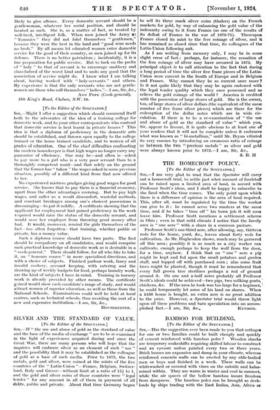SILVER AND THE STANDARD OF VALUE.
[To the Editor of the SPECTATOR.] SIRS If " the use and abuse of gold as the standard of value and the base of the media of exchange " are to be re-examined in the light of experiences acquired during and since the Great War, there are many persons who will hope that the inquiries will embrace silver as an element of such " use " and the possibility that it may be established as the colleague of gold as a base of such media. Prior to 1873, the two metals, gold and silver, were coined at the mints of the five countries of the " Latin-Union "—France, Belgium, Switzer- land, Italy and Greece—without limit at a ratio of 15f to 1, and the gold and silver coins of those countries were " legal tender " for any amount in all of them in payment of all debts, public and private. About that time Germany began
to sell its three mark silver coins (thalers) on the French markets for gold, by way of enhancing the gold value of the indemnity owing to it from France (as one of the results of its defeat of France in the war of 1870-71). Thereupon France closed its mint to the free coinage of silver, and it has remained so closed since that time, its colleagues of the Latin-Union following suit.
As I am writing from memory only, I may be in some slight error of fact : perhaps, for instance, the cessation of the free coinage of silver may have occurred in 1872. My principal object is to call attention to the fact that during a long period of time the silver five franc pieces of the Latin- Union were current in the South of Europe and in Belgium and France. Why cannot they be so current once more Is it not quite likely that they may be again endowed with the legal tender quality which they once possessed and so relieve the gold coinage of the world ? America is credited with the possession of large stores of gold. She is the owner, too, of large stores of silver dollars (the equivalent of the same number of five franc silver pieces) which are there for the redemption of the dollar notes which are in wide cir- culation. If there is to be a re-examination of " the use and abuse of gold as the standard of value " which you, Sir, appear to favour, it is quite obvious to at least one of
your readers that it will not be complete unless it embraces what was known as " bi-metallism," until Mr. Bryan vitiated
its very essence by introducing an erroneous ratio of coinage as between the two " precious metals " as silver and gold were always known prior to 1873.—I am, Sir, &c., S. R. H










































 Previous page
Previous page